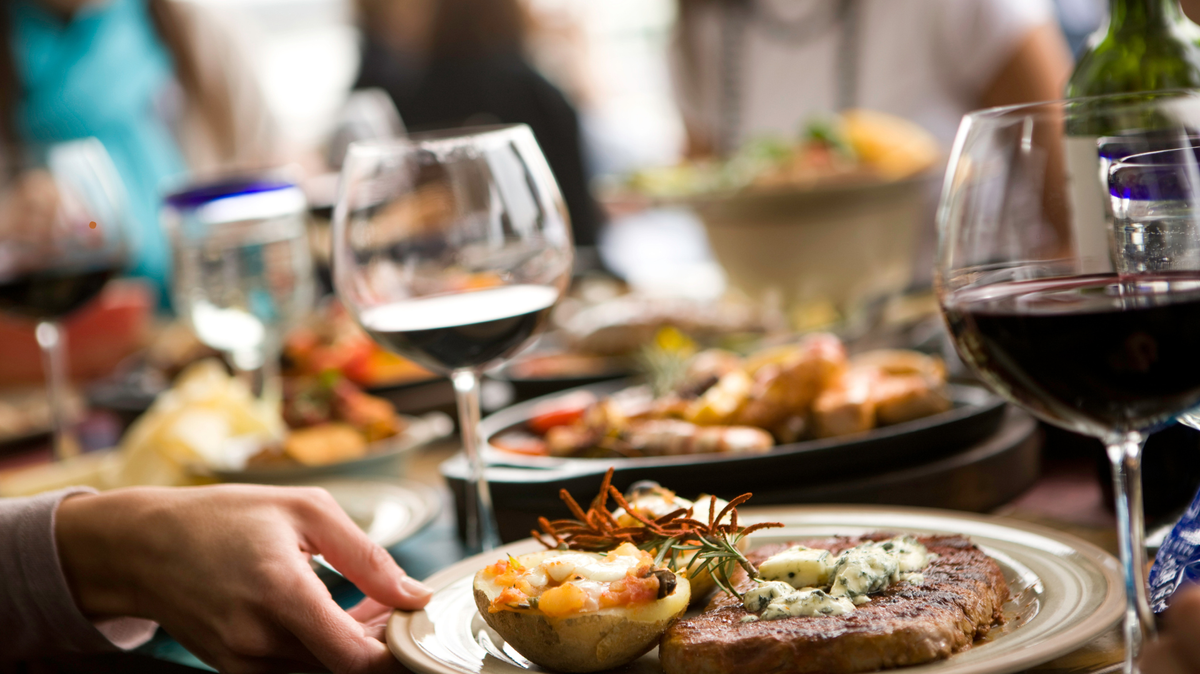Symphony of Drinks in Culinary Traditions
The relationship between alcohol and meals is deeply rooted in history and tradition. From the apéritif that begins a meal to the digestif that concludes it, alcohol has long been a key part of the dining experience.

Alcohol has long played a pivotal role in dining and culinary traditions across the globe. It has been intricately woven into the social and cultural practices surrounding food, influencing how we prepare, serve, and consume meals. From the ritual of the apéritif that signals the start of a meal to the digestif that concludes it, alcohol accompanies the dining experience in various forms.
Preparing the palate
The tradition of starting a meal with an apéritif—a drink designed to stimulate the appetite—has deep historical roots. The term apéritif originates from the Latin aperire, meaning "to open," reflecting its role in preparing the palate for a meal.
The concept of a pre-meal drink dates back to ancient Rome (circa 1st century BCE), where it was common to dilute wine with water and infuse it with herbs and spices. These mixtures served both to aid digestion and stimulate the appetite. Examples include:
- Mulsum: A Roman beverage made by mixing wine with honey and spices. This sweetened wine was believed to stimulate the appetite and aid digestion.
- Posca: A diluted wine or vinegar drink, flavoured with herbs. Though commonly consumed by lower classes and soldiers, it was also used as a refreshing pre-meal beverage.
By the 18th century in France, the apéritif had become a formalised tradition, with various drinks serving both functional and social roles. Modern examples of apéritifs include:
- Vermouth: A fortified wine flavoured with botanicals, served chilled or on the rocks. It comes in styles such as dry and sweet, each contributing to the apéritif tradition.
- Pastis: A French anise-flavoured spirit diluted with water, turning it milky white. It is popular in southern France for its refreshing qualities.
- Champagne: A sparkling wine from the Champagne region of France, known for its crisp, effervescent nature, often used to mark special occasions.
- Gin: Known for its juniper-forward flavour, typically served with tonic water and garnished with lime or cucumber, making it a popular choice for an apéritif.
- Aperol: An Italian orange liqueur with a bittersweet flavour, commonly mixed with prosecco to create the classic Aperol Spritz.
- White wine: Crisp and refreshing, white wine is often served chilled as an apéritif. Its light, acidic profile makes it an excellent choice to awaken the palate.
- Rosé: With its bright, fruity notes and refreshing acidity, rosé has become a popular apéritif choice. It offers a versatile option that pairs well with a variety of appetizers.
Alcohol during the meal
The Greek and Roman influence: The practice of pairing alcohol with main courses has deep historical roots. In ancient Greece, symposia—social gatherings for drinking and conversation—often featured wine paired with various main dishes. For instance, a robust red wine was traditionally enjoyed with hearty lamb stew, while a crisp white wine was paired with fresh seafood. Similarly, in ancient Rome, elaborate banquets showcased sophisticated wine pairings. Roman meals often included wines such as Falernian, which complemented rich meats like roasted boar. These early practices of wine and food pairing greatly influenced European dining customs and contributed to the development of wine as a refined culinary art.
Medieval monasteries and terroir: During the Middle Ages (circa 5th to 15th centuries), monasteries played a crucial role in the evolution of viticulture. Monastic orders such as the Benedictines and Cistercians refined wine production techniques, which laid the groundwork for the concept of terroir—the idea that the geographical environment, including soil, climate, and topography, imparts unique characteristics to the wine. Monks often paired their wines with simple, hearty meals. For example, a robust red wine might be served with a rustic beef stew or a rich game pie. This period also marked the beginning of systematic wine pairing with local cuisine, such as pairing a light, crisp white wine with fish dishes or a full-bodied red wine with venison. The monks’ dedication to quality and local food pairings has had a lasting impact on culinary practices and the appreciation of wine as an integral part of the dining experience.
Modern pairings: Today, the tradition of pairing alcohol with main courses continues to thrive, blending classic and contemporary practices.
- Wine: A crisp Sauvignon Blanc is often paired with seafood or chicken, while a rich Cabernet Sauvignon complements grilled steaks or hearty pasta dishes.
- Beer: Craft beers are paired with main courses such as an IPA with spicy barbecue ribs or a stout with a rich beef stew.
- Spirits: Cocktails have become popular with main courses. For example, a Manhattan pairs well with a grilled steak, while a Negroni complements robust dishes like lamb or pork.
These modern pairings reflect the long-standing tradition of enhancing the main meal experience with thoughtfully selected beverages, celebrating both historical practices and contemporary innovations.
The role of alcohol between and after meals
In the tradition of multi-course dining, the intermezzo and digestif play crucial roles in enhancing the overall meal experience. These practices reflect a sophisticated approach to meal composition and have historical roots in European dining traditions.
The tradition of serving an intermezzo—a light, refreshing drink or sorbet—dates back to elaborate European banquets of the 17th and 18th centuries. The intermezzo serves to cleanse the palate between courses, ensuring that the flavours of each dish remain distinct and that diners are refreshed before continuing with the meal.
Historically, the concept of palate cleansing evolved from the use of aromatic and herbal infusions in medieval and Renaissance European dining. The practice of incorporating a palate cleanser became more formalised during the Renaissance (14th to 17th centuries) when chefs began to introduce a variety of flavours and textures to maintain the balance and interest of multi-course meals.
Notable examples of intermezzos include:
- France: The French tradition of serving a light, citrusy sorbet as an intermezzo became popular in the 19th century. Sometimes, a splash of champagne is added to the sorbet, enhancing its elegance and effervescence. This practice not only refreshes the palate but also adds a sophisticated touch to the dining experience.
- Italy: In Italy, the intermezzo often takes the form of a small glass of limoncello, a zesty lemon liqueur, or grappa, a potent spirit made from grape pomace. These beverages provide a sharp contrast to the preceding dishes, invigorating the senses before the next course.
- Minimalist approach: In some dining traditions, a more minimalist approach is used, such as serving chilled water with a slice of lemon or a sprig of mint. This approach focuses on the functional aspect of palate cleansing, offering a neutral, refreshing pause without introducing additional flavours.
The tradition of serving a digestif—a strong alcoholic drink intended to aid digestion—has its origins in the 18th century. During this period, it was believed that certain spirits could assist with digestion and provide a comforting end to the meal. The digestif tradition reflects the historical belief in the digestive benefits of strong alcoholic beverages.
Notable examples of digestifs include:
- France: Brandy and cognac are classic French digestifs. Cognac, developed in the Cognac region of France in the 17th century, is known for its deep, warming flavours and complex aromas, including notes of vanilla, caramel, and dried fruit. The tradition of sipping cognac as a digestif became widespread during the 18th and 19th centuries. Armagnac, another French brandy, offers a more rustic alternative with pronounced earthy and spicy notes and has been enjoyed since the Middle Ages.
- Italy: In Italy, the tradition of the digestif is particularly strong, with Amari (bitter liqueurs) being a popular choice. Amari have been produced since the 19th century and are made from a blend of herbs, spices, and botanicals. These drinks are believed to stimulate digestion and provide a pleasant finish to the meal.
- Spain: Sherry, a fortified wine from the Jerez region of Spain, has been enjoyed as a digestif since the 16th century. Sherry comes in various styles, from dry and nutty to sweet and rich. Port, a sweet fortified wine from Portugal, has been a popular digestif since the 18th century, often paired with cheese or dessert to end the meal on a sweet note.
- United Kingdom: In the UK, whisky, particularly single malt, is commonly enjoyed as a digestif. The tradition of sipping whisky after a meal has been well ingrained since the 19th century, providing a satisfying and complex end to the dining experience. Irish whiskey, known for its smooth and slightly sweet character, is also a popular choice.
The practice of enjoying a digestif serves not only as a way to aid digestion but also as a cultural ritual. It reflects the traditions and preferences of various regions, offering a meaningful and enjoyable conclusion to the dining experience.
Alcohol plays a central role in social rituals and celebrations, symbolising hospitality and enhancing the dining experience. The tradition of toasting is common across cultures:
- France: "À votre santé" (To your health) reflects a cultural emphasis on health and conviviality.
- Italy: "Cin cin" or "Salute" is a customary toast, often accompanied by a smile.
- UK: "Cheers" serves as a universal expression of goodwill and camaraderie.
Alcohol is integral to many religious and ceremonial meals. In Christianity, wine is central to the Eucharist, symbolising the blood of Christ. In Jewish traditions, wine features in ceremonies such as the Kiddush, a blessing over the wine.
Alcohol enhances the sensory experience of dining by interacting with the flavours of food. The acidity of wine can cut through the richness, while the bitterness of an amaro can balance the sweetness. This interplay is central to the enjoyment of a meal, showcasing local ingredients and culinary heritage.
The knowledge of selecting and pairing wine is often passed down through generations, preserving cultural heritage. In regions like Bordeaux, Burgundy, and Scotland, traditions in wine and whisky-making are handed down, reflecting both technical skills and cultural values.
The relationship between alcohol and meals is deeply rooted in history and tradition. From the apéritif that begins a meal to the digestif that concludes it, alcohol has long been a key part of the dining experience. It enhances flavours, aids digestion, and fosters conviviality. As dining practices evolve, the traditions surrounding alcohol will continue to adapt, celebrating history, culture, and community. The integration of alcohol into meals is not just a culinary practice but a reflection of our collective cultural memory—a way to honour the past, celebrate the present, and look forward to the future.





